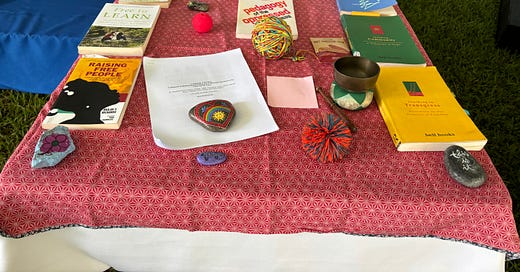Dearly beloved Enchantable readers,
There is a lot I could write to you about today. My grandma passed away this week at the age of 97. It was Daphne’s 6th birthday. The academic year ended with the commencement ceremony. It was a big, exhausting, very full week - full of love and joy and grief and rage, for to live in these times is to live with all of these experiences at the same time.
For the graduation ceremony, my peace education students chose to build a learning altar as their offering and contribution to the ceremony, so that is what I would like to share with you today. It was very meaningful to me that this is what they wanted to offer, that this is how they chose to share about their learning with the community and mark the end of the year. I am truly so proud of them and all they have become and created this year, each and every one, and together.
Building learning altars is a practice I have been meaning to share for a long time, and I was actually surprised I hadn’t written about here yet in a descriptive way (I have mentioned it a lot, and featured many learning altar photos). It is part of the Peek into Process series and a follow-up post to Tools of the Trade.
I love altar-making as a spiritual practice, and I build little altars everywhere. I have several in different places in my home, inside and outside, and love to make public communal altars such as the forest pedestal and the tree altar. In my classes and other spaces of learning, we have a practice of building collective learning altars as a pedagogical practice, and that is what I would like to share with you today in three parts: poetics, logistics, and the graduation activity.
Part 1: Poetics
Altar. Noun. A religious or spiritual offering space.
Alter. Verb. To change, transform, in small but significant ways.
The creation of a learning altar is a practice of transforming the learning space and transforming ourselves. It is the act of declaring that learning is a sacred process. It is an intentional disruption of capitalist notions of teaching and learning as transaction and consumption. A learning altar declares, “You are an intellectual, spiritual, emotional, physical being. All of you is welcome here.”
A learning altar creates a space for offering, for exchange, for reciprocity. The altar is an invitation to share some of yourself in this space, to share as much or little as you want. It is not required. What you bring and what you share is an offering to the community, una ofrenda.
To offer is to give without expectation, to give from a place of reciprocity and humility adn generosity. A learning altar is an invitation to offer, not just to the altar, but to the learning community through our sharing, listening, attention, and heart. It is an invitation to lend, for what you offer can be taken back, given temporarily.
Altar-making is a transcultural peace practice, as altars are a common practice across many cultures and religious and spiritual traditions across the world. It is a way of unifying across diverse cultural and spiritual traditions, even though altars may look very different across contexts.
A learning altar beautifies the space. It creates a focal point in a distracted world, a place for our attention to return to and remind us why we are here. In what can be otherwise sterile classroom environments of blank walls and computer screens, a learning altar brings beauty, creativity, and art.
A learning altar is a way of honoring those we learn from and with. In peace education classes, we create a lineage altar to acknowledge all those upon whose shoulders we stand, our families, our teachers, the places where we come from and hold us. We place the books and readings we are learning with that day on the altar as a way of honoring their knowledge and wisdom, as a way of orienting towards the readings through relationship rather than consumption. We think with these writers across space and time.
A learning altar is a way to humanize those we are reading with. In academia, the act of citation, while important and necessary, can also be dehumanizing, reducing authors to a last name. Authors are people too, whole human beings, and by placing their works on the altar, we are reminded of who we are learning with each day, their body of work, and that often it is coming from a much larger work (disrupting the academic tendency to extract small slivers). It is not to place them on a pedestal beyond critique, but rather a place of reverence and appreciation, where critique can still be welcome.
A learning altar is a way of bringing elements from nature into the classroom, reminding us that we, too, are nature. Stones ground us, and are later used as talking objects when we have circle dialogues. Flowers found on the way to class imbue the space with color and beauty.
A learning altar re-enchants the classroom. The act of re-enchantment is radical, is returning learning to a state of awe and wonder instead of seeking one right answer.
A learning altar alters the space, and a learning altar alters us in its construction and its presence.
A learning altar offers a space of dedication. We dedicate this learning altar to the class of 2024. To the people and places that have allowed us to be here. To this magnificent land for holding us, and to the original stewards, the Huetar people, for tending this land. To the community that allows us to be here, and the many beautiful souls at UPEACE who keep this place running and offer their smiles and care to this learning community. We dedicate our learning to the more just and peaceful world we yearn for, that we commit ourselves to working towards.
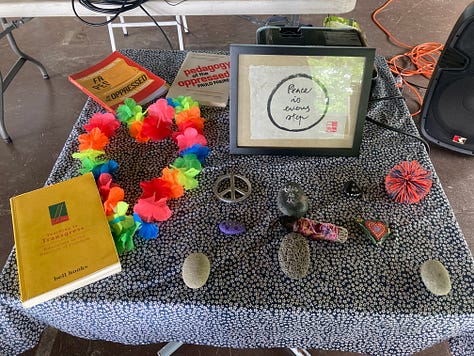
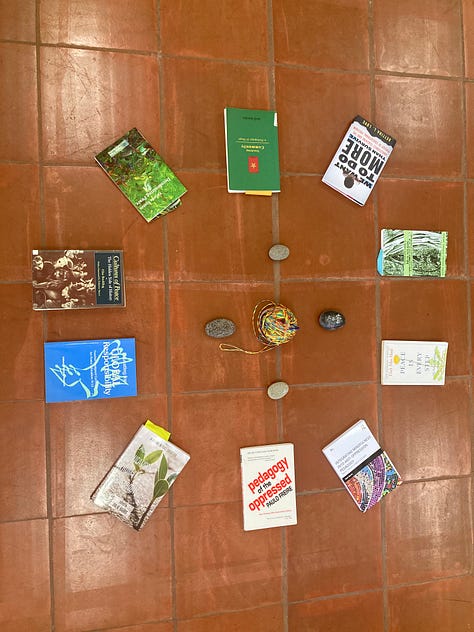
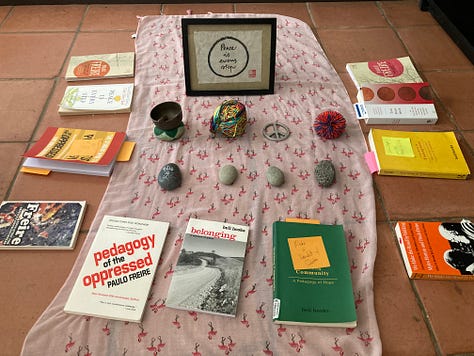
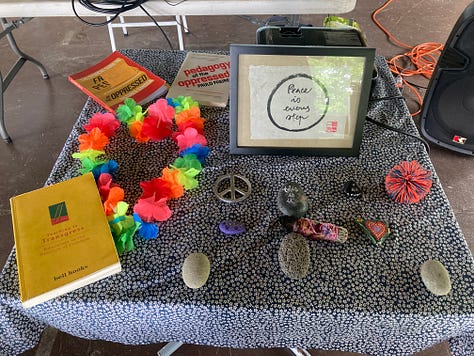
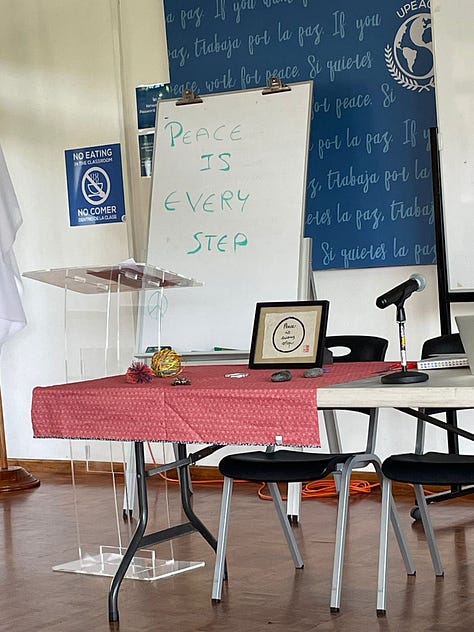

Part 2: Logistics (the how-to)
I preface this with: make it your own. You can make an altar any way you want. It can be simple or complex. The most important part is the intention. Mine is described above, but you can create your own.
People pass by the classroom, and they say, “Wow!” It does not take much for a learning altar to be beautiful and profound. It is a simple yet intentional act to beautify the space and declare it as sacred, to bring love and care into the learning space.
You can make an altar with anything. You don’t need to go out and get anything (in fact, please don’t!). You can make an altar with objects you have on hand or rocks, leaves, flowers.
Our learning altar often consists of:
A cloth
stones and rocks of significance (I have a large collection at this point)
books or articles we are reading with
Pictures or art
Playful items like a Koosh ball and clown nose which can also serve as talking objects (I like to have objects that signify play and joy as a way to remember that they are welcome and encouraged)
Depending on the classroom I am in, I either place the altar in the middle or in the front, on the floor or on a table.
Prompts for creating an altar together
You can make an altar for anything. The prompts I often use are:
Bring something that represents your lineage (teaching/learning or ancestral)
Bring something that represents peace to you
Write the name of a teacher
What do you want to intentionally bring into this space? (see example of Koosh ball and clown nose above)
The name of the teacher can be done on the spot, but for the others, it is nice to give to people ahead of time so they can bring items with them.
I always have an altar space set up. Usually, on the second day I am with a group, I will invite them to bring an item using one of the above prompts and we will create an altar together. Each day I have a space set up and I rotate the learning materials depending on what we are working with that day. The space is always offered as a place for students to add or bring things as they are inspired.
Part 3: The Graduation Speech
I also want to share the text I read for the graduation ceremony, which repeats much of Part 1 in a more succinct way. I am also including the line that was improvised in bold, inspired by the students’ graduation act of resistance.

You can watch our part of the ceremony here.
Script:
It is my great joy to stand here today with our class of 2024 peace education beloved learning community and introduce our activity, Building a Learning Altar. I am so proud that this is how our learning community has chosen to demonstrate their learning here today, and I am so honored to stand here with them. I also want to give voice to what some of them have written on their [stoals], NO COMMENCEMENT IN GAZA.
In our peace education classes, we create alternatives to mainstream learning - “construyendo alternativas de aprendizaje,” as this presentation title was beautifully translated into Spanish. A central part of our learning practice is intentionally arriving together, and we use a mindfulness bell to support this invitation. We do this because peace is not possible if we are not present, and cultivating focused attention is a radical act in a distracted world. In this spirit, I invite us to listen to three bells and take three breaths together.
The first breath is for ourselves, just as we are in this moment.
The second breath we offer in support of this learning community, of which each one of us is a part, for you, dear guests, have also been a part of this learning community in your support of our students.
The third breath is for the wider whole of which we are all a part, including the lands that hold us, and our vast relational webs, seen and unseen.1
(Three bells)
Another practice we have is building learning altars.
The word altar, in English, has two spellings and two meanings.
An altar (with an a), is a noun that describes a religious or spiritual offering space.
To alter (with an e), is a verb that means to change or transform in small but significant ways.
Our learning altars invoke both meanings.
The creation of a learning altar is a practice of transforming the learning space and transforming ourselves. It is the act of declaring that learning is a sacred process, which disrupts capitalist notions of teaching and learning as transactional and as consumption. A learning altar declares, “We are intellectual, spiritual, emotional, physical beings, and we are fully welcome here.” We build learning altars to honor our lineages and teachers, the ones who we are learning from and with. Altar-making is an intercultural peace practice, as altars are common across many cultures and traditions around the world. We build learning altars to create a space for offering, sharing, and reciprocity, a space of beauty,
A learning altar alters the space, and a learning altar alters us in its construction and its presence. We invite you to be altered with us through today’s offering. I now pass it to Abby, who will share about our peace education rock.
The academic year is over. There is still much grading to be done before I can lay on the forest floor and become compost. I have so much to compost after these weeks and months.
Or as one of my students said to me earlier this year, “Maybe you need to ferment yourself.”
To ferment requires stillness. To ferment is to breakdown.
I am ready to break down and be still. Then, to become effervescent.
With love and care,
Stephanie
Thank you to my dear friend Minna for introducing me to this three breaths practice.

